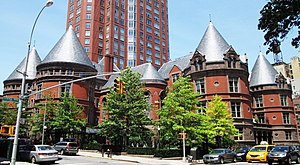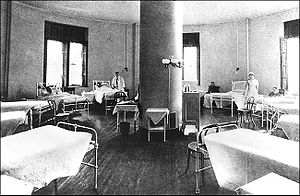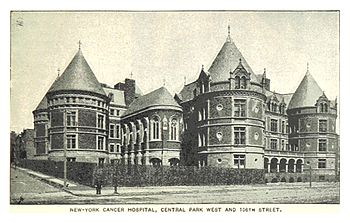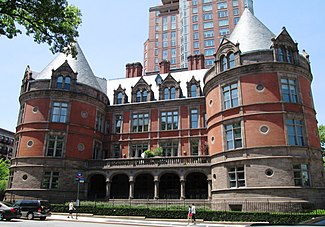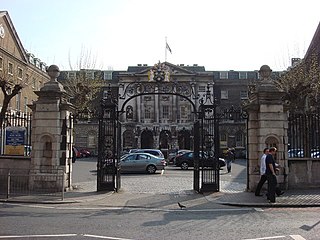
Guy's Hospital is an NHS hospital in the borough of Southwark in central London. It is part of Guy's and St Thomas' NHS Foundation Trust and one of the institutions that comprise the King's Health Partners, an academic health science centre.

The University of Texas MD Anderson Cancer Center is a comprehensive cancer center in Houston, Texas. It is the largest cancer center in the U.S. and one of the original three comprehensive cancer centers in the country. It is both a degree-granting academic institution and a cancer treatment and research center located at the Texas Medical Center in Houston. It is affiliated with The University of Texas Health Science Center at Houston. According to Newsweek, MD Anderson Cancer Center is considered the best hospital in the world for oncology and related cancer treatment.
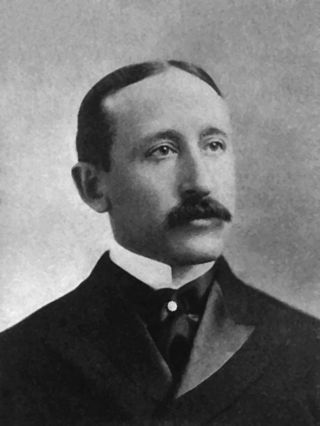
James Stephen Ewing was an American pathologist. He was the first Professor of pathology at Cornell University and discovered a form of bone cancer that was later named after him, Ewing sarcoma.

Memorial Sloan Kettering Cancer Center is a cancer treatment and research institution in the borough of Manhattan in New York City, founded in 1884 as the New York Cancer Hospital. MSKCC is one of 52 National Cancer Institute–designated Comprehensive Cancer Centers. Its main campus is located at 1275 York Avenue, between 67th and 68th streets, in Manhattan.
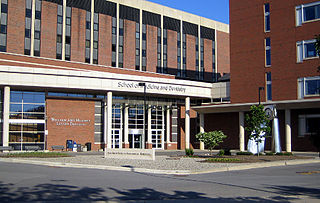
The University of Rochester Medical Center (URMC), now known as UR Medicine, is located in Rochester, New York, is one of the main campuses of the University of Rochester and comprises the university's primary medical education, research and patient care facilities.
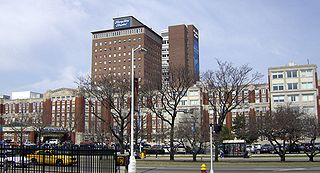
Henry Ford Hospital (HFH) is an 877-bed tertiary care hospital, education and research complex at the western edge of the New Center area in Detroit, Michigan. The flagship facility for the Henry Ford Health System, it was one of the first hospitals in the United States to use a standard fee schedule and favor private or semi-private rooms over large wards. It was the first hospital in the country to form a closed, salaried medical staff. As founder Henry Ford viewed tobacco as being unhealthy, the hospital was one of the first in the United States to institute a total ban on smoking. Henry Ford Hospital is staffed by the Henry Ford Medical Group, one of the nation's largest and oldest group practices with 1,200 physicians in more than 40 specialties.
The Christie NHS Foundation Trust in Withington, Manchester, manages the Christie Hospital, one of the largest cancer treatment centres of its type in Europe. The Christie became an NHS Foundation Trust in 2007 and is also an international leader in cancer research and development, home to the Paterson Institute for Cancer Research.

Maimonides Medical Center is a non-profit, non-sectarian hospital located in Borough Park, in the New York City borough of Brooklyn, in the U.S. state of New York. Maimonides is both a treatment facility and academic medical center with 711 beds, and more than 70 primary care and sub-specialty programs. As of August 1, 2016, Maimonides Medical Center was an adult and pediatric trauma center, and Brooklyn's only pediatric trauma center.
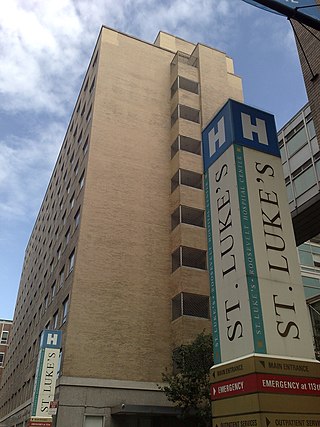
Mount Sinai Morningside, formerly known as Mount Sinai St. Luke's, is a teaching hospital located in the Morningside Heights neighborhood of Manhattan in New York City. It is affiliated with the Icahn School of Medicine at Mount Sinai and the Mount Sinai Health System, a nonprofit hospital system formed by the merger of Continuum Health Partners and the Mount Sinai Medical Center in September 2013. It provides general medical and surgical facilities, ambulatory care, and a Level 2 Trauma Center, verified by the American College of Surgeons. From 1978 to 2020, it was affiliated with Mount Sinai West as part of St. Luke's–Roosevelt Hospital Center.

The Institute of Pennsylvania Hospital, also known as Kirkbride's Hospital or the Pennsylvania Hospital for Mental and Nervous Diseases, was a psychiatric hospital located at 48th and Haverford Streets in Philadelphia, Pennsylvania, USA. It operated from its founding in 1841 until 1997. The remaining building, now called the Kirkbride Center is now part of the Blackwell Human Services Campus.

Charles Coolidge Haight was an American architect who practiced in New York City. He designed most of the buildings at Columbia College's now-demolished old campus on Madison Avenue, and designed numerous buildings at Yale University, many of which have survived. He designed the master plan and many of the buildings on the campus of the General Theological Seminary in Chelsea, New York, most of which have survived. Haight's architectural drawings and photographs are held in the Dept. of Drawings and Archives at the Avery Architectural and Fine Arts Library at Columbia University in New York City.

Vesey Street is a street in New York City that runs east-west in Lower Manhattan. The street is named after Rev. William Vesey (1674-1746), the first rector of nearby Trinity Church.

The Association Residence Nursing Home, also called the Association for the Relief of Respectable, Aged and Indigent Females, is an historic building in New York City built from 1881–1883 to the design of Richard Morris Hunt in the Victorian Gothic style. It is located on Amsterdam Avenue between 103rd and 104th Streets on the Upper West Side of Manhattan, and is now a hostel run by Hostelling International. The Association was founded in 1814 to help the widows of soldiers of the American Revolutionary War and the War of 1812. An addition to the building was constructed on the south end of the property in 1907, which contained seven Tiffany windows which are now in the collection of the Morse Museum of American Art. The building was placed on the National Register of Historic Places in 1975.

The Prentice Women's Hospital and Maternity Center was a hospital on the Downtown Chicago campus of Northwestern University's Northwestern Memorial Hospital in the Streeterville district of Chicago's Near North Side.

Henry Harrington Janeway was an American physician and pioneer of radiation therapy.

Helene Fuld College of Nursing is a private nursing school in New York City. The college offers associate and comprehensive baccalaureate science degrees to Licensed Practical Nurses, Registered Nurses, and individuals who are not already nurses. The college is located in the East Harlem section of Manhattan in the Mount Morris Park Historic District across from Marcus Garvey Park. It was founded in 1945.

Mount Sinai West, opened in 1871 as Roosevelt Hospital, is affiliated with the Icahn School of Medicine at Mount Sinai and the Mount Sinai Health System.
Auburn Community Hospital (ACH) is a acute-care medical facility in Auburn, New York. The hospital hosts a VA community-based outpatient clinic. ACH is the largest employer in Cayuga County.
